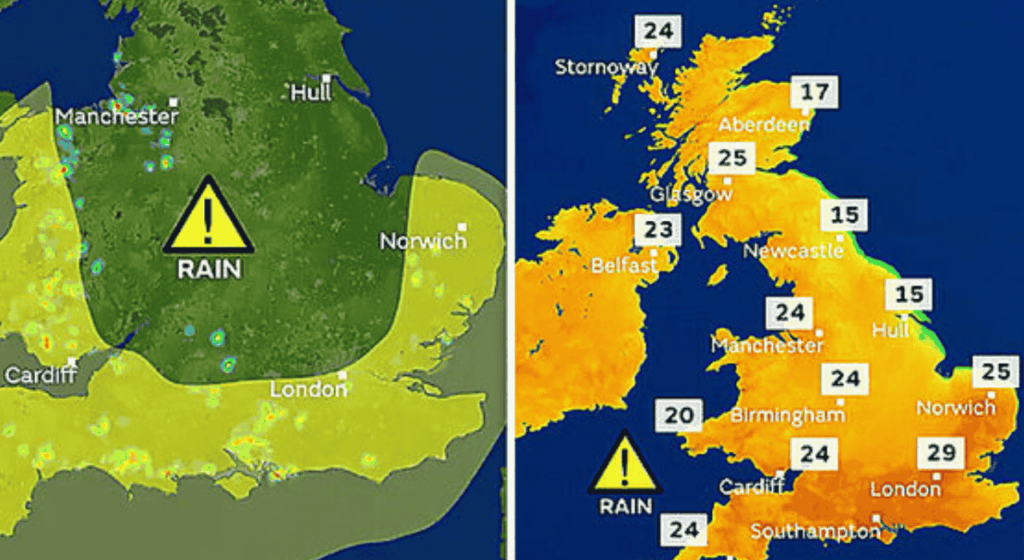The Met Office has issued a red weather warning for parts of the UK, citing the risk of severe weather due to the arrival of Storm Darragh. This warning, the most severe in the Met Office system, highlights the risk to life, property and infrastructure in affected areas. With a red weather warning in force for Bristol and other areas of the South West, it is crucial to understand the warning system and how to stay safe during this extreme weather event.
As areas across the UK face disruption – from strong winds and heavy rain to potential flooding – the impact on daily life, transport and infrastructure is significant. As communities prepare for these challenges, the Met Office continues to provide real-time safety updates and advice, with a focus on preparedness and cooperation to mitigate risks during this extreme weather event.
Understanding Met Office weather warnings
Types of weather warnings
The Met Office weather warning system uses three colours – yellow, amber and red – to convey the severity of weather conditions. Yellow indicates potential disruption, yellow indicates increased risks to life and property, and red weather warnings represent the most dangerous conditions. A red weather warning in the UK means there is a high chance of life-threatening impacts, urging people to take immediate action.
How are weather warnings issued?
To forecast severe weather conditions, the Met Office uses advanced weather tools, including satellite data, computer models and local observations. Collaboration with local authorities ensures that Met Office weather warnings are issued in a timely manner, reducing risks and protecting communities.
Current weather situation in the UK
Storm Darragh overview
On 7 December, Storm Darragh will bring severe weather to south-west England and Wales. The UK’s red weather warning for these areas highlights the risk of strong winds, heavy rainfall and flooding. Met Office weather warnings stress staying at home and avoiding non-essential travel.
Areas affected
The main areas under red weather warnings include Bristol and neighbouring areas in the south-west. Amber warnings for wind extend to Northern Ireland, Scotland and the north of England, while yellow warnings for rain and snow affect parts of Scotland. These alerts reflect widespread disruption across the UK.

Potential risks
Strong winds could uproot trees, damage property and cause widespread power outages. Flooding and travel disruption are also expected. The Met Office advises caution, particularly in areas subject to red weather warnings in the UK, as the risks to life and infrastructure are significant.
Impact on local communities and infrastructure
Travel and transport disruption
The storm is likely to disrupt public transport and trains and flights are expected to be cancelled. Roads may become impassable due to falling debris and flooding, further impacting the weather in Bristol and other affected areas.
Community and power supply concerns
Power outages are a major concern, as high winds can damage power lines and essential infrastructure. Communities in affected areas are preparing by securing properties and stocking emergency supplies. Local authorities are coordinating efforts to reduce the impact of the storm.
How to Stay Safe
Preparation Tips
During a red weather warning, safety starts with preparation. Secure outside items, avoid travel, and monitor updates on the Met Office website or app. Having an emergency kit, including food, water, and flashlights, is essential to deal with a potential power outage.
Emergency contacts and resources
Keep contact information for local emergency services and service providers handy. Red weather warnings issued by the Met Office provide vital updates, and their guidance should be followed closely to stay informed and safe. Always have emergency plans in place and stay connected with the latest advisories to ensure safety during a red weather warning.
A look ahead: weather forecast
Short-term forecasts
Following the storm, the weather is expected to turn colder and high pressure systems to form across the UK. While calmer conditions may prevail, vigilance remains critical for areas recovering from the aftermath of the storm.
Climate considerations
Events such as Storm Darragh highlight the increasing frequency of extreme weather patterns affected by climate change. The Met Office’s weather forecasting tools are critical in helping communities prepare for such events, reflecting its commitment to protecting lives and infrastructure.Recognizing the importance of red weather warnings ensures that individuals and authorities can take timely action to mitigate risks.
Conclusion
The Met Office’s red weather warning highlights the importance of preparation and caution during severe weather. With risks ranging from flooding to power outages, understanding and acting on Met Office weather warnings is vital to protecting lives. By staying informed and following advice, communities across the UK can weather this storm with resilience and safety.
